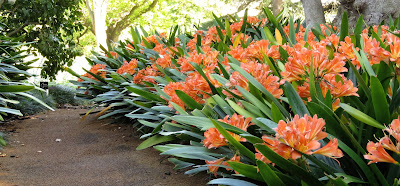Clive of Syon Park
Did you, like me, think that the popular orange-flowered bulb Clivia was named after Robert Clive, aka 'Clive of India'? I've been promulgating this lie every time I explain to someone why Clivia should be pronounced with a long, rather than short, i (as in bright rather than brilliant).
As it turns out - and thanks Michael Barrett (President of the Melbourne Clivia Group and key organiser of the Clivia Expo 2016) - the genus was named after Robert(Clive of India)'s granddaughter, Duchess Charlotte. Thankfully the pronunciation remains the same.
Lady Charlotte Florentia Clive was Duchess of Northumberland, spending her springs and summers across the Thames from Kew Gardens, in Syon House (in Syon Park).
She was Princess Victoria's State Governess, appearing with Victoria on official occasions but apparently doing little else to educate the future Queen, partly due a fear that she might subvert the young mind (to horticulture perhaps?). The Duke and Duchess had no children but Charlotte - with some help from her gardener Richard Forest - was a dab hand at keeping cliveas alive in the conservatory at Syon House.
I've featured Syon Park, the surrounds of Syon House, before, but at night. Here is what it looks like from across the Thames, standing in Kew Gardens. You can see the lion which notoriously faces its backside towards Windsor House.
Lady Charlotte grew her exotic plant material in the Great Conservatory, still there today and carefully restored 30 years ago. I captured it somewhat obscurely in this picture from my night time visit in 2011.
In their homeland - coastal and inland forests of southern Africa - the five or six species of Clivia grow mostly in cool, shaded habitats. A species discovered in only 2002, Clivia mirabilis, is the exception, frequenting semi-arid areas with winter rather than summer rain.
You can find out more about the discovery, ecology and horticulture of this genus at the Clivia Society website or in an article by Graham Duncan in the latest issue of Curtis's Botanical Magazine (including extensions to the natural range of Clivia miniata in southern Africa).
In both accounts you'll learn that James Bowie, collector and gardener at Kew Gardens, sent the first horticultural material back to England in the 1820s where it made its way across the river to Syon Park. It was there the first flowers were produced and sketched, forming the basis of two botanical papers published on exactly the same October day in 1828. John Lindley's name Clivia has been given priority over Imatophyllum, the name coined by Director of Kew Gardens, William Hooker.
That species was Clivia nobilis (or Imatophyllum aitonii in Hooker's paper), but the orange-flowered plants that feature in botanic gardens and other grand gardens across Australia today are mostly cultivars of Clivia miniata. This second species found its way to England in the 1850s, although it took a decade or so for botanists to realise it was closely related to Clivia nobilis and should therefore carry the 3rd Duchess of Northumberland's surname.
And to correct another misconception, clivia flowers are not always orange. You might have seen the occasional yellow-flowered form but they can also be creamy white, red or even green. New colours and infusions continue to be created through breeding, including picotee forms (a term used mostly for carnations and tulips with dark tipped petals) such as the sorbet coloured bloom at the top of the post - a Clivia miniata cultivar, a cross between 'Electra King' and 'Tango'. Also at the very top of this post is a clump of regular Clivia miniata doing very nicely at Burnley Gardens.
Then there are doubles, with extra petals, and to my horror, variants with variegated leaves (I have a thing about variegated plants).
Here are a few selections from Saturday's Clivia Expo, with Michael Barrett featuring in the first, along with one of the famous yellow forms of Clivia miniata (sometimes called var. citrina).
This is one of your fairly typically shaped and coloured Clivia miniata flowers.
This next flower is more typical of the genus Clivia: all but Clivia miniata have pendent flowers. It's a cross between a natural Clivia caulescens and Clivia miniata hybrid and the more arid tolerant Clivia mirabilis.
And finally, this creamy green one is Clivia miniata 'Hirao'.










Comments
The MCG website, under the membership page has some 2013 newsletters available to view online. I hope the information contained in these newsletters will inspire you to grow a few more Clivia.